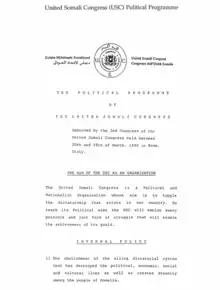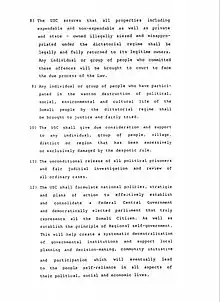United Somali Congress | |
|---|---|
| Commander/leader | Mohamed Farrah Aidid,[1] Ali Mahdi Muhammad |
| Founded | 1987 |
| Dissolved | 2000 |
| Headquarters | Mogadishu |
| Ideology | Anti-communism Anti-Siad Barre Islamism Somali nationalism Greater Somalia Hawiye interests |
| Colours | Green |
The United Somali Congress (USC) was one of the major rebel organizations in Somalia. Formed in 1989, it played a leading role in the ouster of the government of Siad Barre in 1991, and became a target of the Unified Task Force campaign in 1993. Following infighting, the USC later splintered into smaller groups. By 2000, with the establishment of a Transitional National Government (TNG), a process of disarmament was put in motion and some moderate ex-USC leaders were incorporated into the new interim administration.
History


With its base centered on the Hawiye clan, the United Somali Congress was established in Rome on 7 January 1989 by Ali Mohamed Osoble (Ali Wardhigley) and others. Although its members largely started off as associates of SODAF, SSDF and SNM, the USC in Rome had its own political program that offered a decentralised system to address the growing discontent with central rule after 10 years of rebel opposition.[2]
"The USC shall formulate national policies, strategy and plans of action to effectively establish and consolidate a Federal Central Government and a democratically elected parliament that truly represents all the Somali citizen. As well as establish the principle of regional self government. This will help create a systematic decentralisation of governmental institutions and support local planning and decision-making, community initiative and participation which will eventually lead to the people self-reliance in all aspects of their political, social and economic lives"
The USC military wing was formed in late 1989 in Ethiopia, and led by General Mohamed Farrah Aidid until his demise in 1996.[3] He was succeeded by his son Hussein Mohamed Farrah, by which time the Aidid faction of the organization was also known as the Somali National Alliance (SNA), often the USC/SNA.
The USC was formed in response to severe acts against the Hawiye tribe by the government of Mohamed Siad Barre. During the period of 1989 to 1991, President Barre launched massive crackdowns and use of force against the Hawiye in their homeland in Southern and Central Somalia. The most notable incidents were in Central Somalia in the area near Galkacyo in November 1989 which resulted in the deaths of many civilians at the hands of the Somali National Army. These mass deaths resulted in the future USC Chairman, General Mohammed Farah Aidid quitting his post as Somali Ambassador to India and joined the USC training camps in Mustahiil, Ethiopia.
Military successes by the USC[4] [5][6] would be instrumental in bringing about the ouster of the Barre government on January the 26th 1991, with the ruler fleeing into exile in Kenya. Despite the Kenyan Government militarily supporting Barre in his fight with the USC before and after his overthrow,[7] the USC pursued Barre's forces into Kenya causing a long diplomatic and military row with President Daniel Arap Moi[8][9] before he was offered by the then-OAU to retire in Lagos, Nigeria. Despite the victory however, the USC had failed to manage a political settlement with its rivals, the SNM, SPM and the SSDF, and also fragmented within its own leadership after Ali Mahdi Muhammad was declared interim President.
Upon the naming of Ali Mahdi Muhammed as President, the USC split into two. The USC/SNA emerged under Mohammed Aidid and the United Somali Congress/Somali Salvation Alliance (USC/SSA) of Ali Mahdi Muhammed. The USC/SNA came under the control of Mohamed Aidid's son, Hussein Mohamed Farah Aidid after the father's death in 1996. The USC/SSA eventually came under control of the Deputy Chairman, Musa Sudi Yalahow.
Both USC factions made peace with each other in August 1998, though this caused a violent split between Yalahow and Ali Mahdi Muhammed, and fighting continued in Mogadishu. Eventually, both Hussein Aidid and Yalahow reconciled and joined the Somali Reconciliation and Restoration Council (SRRC) in 2002, in opposition to the Transitional National Government (TNG). This caused a rift between the USC/SSA supporters of Yalahow and Omar Muhamoud Finnish (also known as Mahmud Muhammad Finish), who continued to support the TNG. Fighting between the two caused many deaths in Mogadishu.[10]
In 2001, Hussein Aidid founded the Somalia Reconciliation and Restoration Council (SRRC), a new armed opposition group. Growing out of the Somali National Alliance, it was originally formed to oppose the nascent Transitional National Government (TNG) and the Juba Valley Alliance (JVA) in the 2001–2004 period. However, it eventually settled its differences with the government in 2003, with some moderate leaders incorporated into the new interim administration.
Notable personnel
Timeline of the USC
- 1987–1991 USC foundation to the overthrow of Siad Barre
- 1991–1992 Mohammed Aidid (USC Aidid) vs. Ali Mahdi Mohammed (USC Mahdi) until the foundation of the USC/SNA
- 1992–1995 USC/SNA and USC/SSA vs the UN intervention
- 1995–1998 USC/SNA vs. USC/SSA after the UN departure until the reconciliation
- 1998–2001 USC/SSA infighting between Ali Mahdi Mohammed and Musa Sudi Yalahow
- 2001–2002 USC/SSA infighting between Musa Sudi Yalahow (SRRC) vs. Omar Muhamoud Finnish (TNG)
- 2003–Several USC commanders disarm their militia; some incorporated into nascent interim government
See also
References
- ↑ "United Nations Consolidated Inter-Agency Appeal for Somalia" (PDF). OCHA. 1998.
- ↑ Brons, Maria (1992). Society, Security, Sovereignty and the State in Somalia From Statelessness to Statelessness?. p. 208. ISBN 9789057270383.
- ↑ "Appendix A: Main Events in Somalia's History". United Nations Consolidated Inter-Agency Appeal for Somalia (PDF). Geneva: OCHA. December 1998. p. 105. Archived from the original (PDF) on January 24, 2004.
- ↑ Of Immigration, Board (1993). Somalia: Information on the situation in Baidoa and El Wak from 1991 to 1993, and in El Wak in 1996.
- ↑ Alasow, Omar (2010). Violations of the Rules Applicable in Non-International Armed Conflicts and Their Possible Causes.
- ↑ Duyvesteyn, Isabelle (2010). Clausewitz and African War, Politics and Strategy in Liberia and Somalia.
- ↑ Report, Daily (1992). Daily Report Africa (Sub-Sahara) Issues. Foreign Broadcast Information Service. p. 4.
- ↑ Review, The Weekly (1992). The Weekly Review. Stellascope Limited. p. 36.
- ↑ Review, The Weekly (1992). The Weekly Review. Stellascope Limited. p. 37.
- ↑ "SOMALIA: At least 12 killed in Mogadishu fighting". IRIN. February 26, 2002. Retrieved February 7, 2007.
External links
- World Travel Guide – History and Government of Somalia
- Dagne, Ted (2002). "Africa and the War on Terrorism". CRS Report for Congress, Washington (DC):Library of Congress.